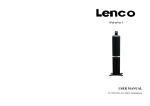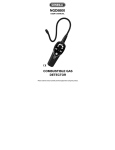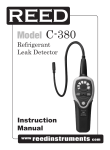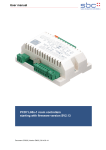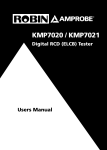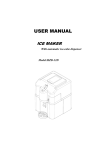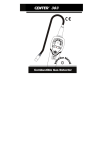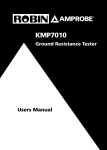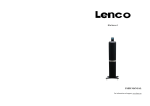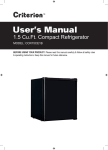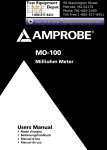Download Users Manual - Test Equipment Depot
Transcript
99 Washington Street Melrose, MA 02176 Phone 781-665-1400 Toll Free 1-800-517-8431 Visit us at www.TestEquipmentDepot.com RLD-1 Refrigerant Leak Detector Users Manual • Mode d’emploi • Bedienungshandbuch • Manual d’Uso • Manual de uso Refrigerant Leak Detector Users Manual July 2009, Rev.1 ©2009 Amprobe Test Tools. All rights reserved. Printed in Taiwan English RLD-1 Limited Warranty and Limitation of Liability Your Amprobe product will be free from defects in material and workmanship for 1 year from the date of purchase. This warranty does not cover fuses, disposable batteries or damage from accident, neglect, misuse, alteration, contamination, or abnormal conditions of operation or handling. Resellers are not authorized to extend any other warranty on Amprobe’s behalf. To obtain service during the warranty period, return the product with proof of purchase to an authorized Amprobe Test Tools Service Center or to an Amprobe dealer or distributor. See Repair Section for details. THIS WARRANTY IS YOUR ONLY REMEDY. ALL OTHER WARRANTIES - WHETHER EXPRESS, IMPLIED OR STAUTORY - INCLUDING IMPLIED WARRANTIES OF FITNESS FOR A PARTICULAR PURPOSE OR MERCHANTABILITY, ARE HEREBY DISCLAIMED. MANUFACTURER SHALL NOT BE LIABLE FOR ANY SPECIAL, INDIRECT, INCIDENTAL OR CONSEQUENTIAL DAMAGES OR LOSSES, ARISING FROM ANY CAUSE OR THEORY. Since some states or countries do not allow the exclusion or limitation of an implied warranty or of incidental or consequential damages, this limitation of liability may not apply to you. Repair All test tools returned for warranty or non-warranty repair or for calibration should be accompanied by the following: your name, company’s name, address, telephone number, and proof of purchase. Additionally, please include a brief description of the problem or the service requested and include the test leads with the meter. Non-warranty repair or replacement charges should be remitted in the form of a check, a money order, credit card with expiration date, or a purchase order made payable to Amprobe® Test Tools. In-Warranty Repairs and Replacement – All Countries Please read the warranty statement and check your battery before requesting repair. During the warranty period any defective test tool can be returned to your Amprobe® Test Tools distributor for an exchange for the same or like product. Additionally , in the United States and Canada In-Warranty repair and replacement units can also be sent to a Amprobe® Test Tools Service Center (see address below). Non-Warranty Repairs and Replacement – US and Canada Non-warranty repairs in the United States and Canada should be sent to a Amprobe® Test Tools Service Center. Call Amprobe® Test Tools or inquire at your point of purchase for current repair and replacement rates. Non-Warranty Repairs and Replacement – Europe European non-warranty units can be replaced by your Amprobe® Test Tools distributor for a nominalv charge. Test Equipment Depot - 800.517.8431 99 Washington Street Melrose, MA 02176 TestEquipmentDepot.com RLD-1 Refrigerant Leak Detector 1 2 3 8 4 5 7 6 9 10 11 1 Sensor 2 Sensor Protector 3 LED Leak Indicators 4 Sensitivity Lo Button 5 Power On/Off 6 Reset Button 7 Sensitivity Hi Button 8 Low Battery Indicator 9 Battery Cover 10 Battery Cover Screw 11 DC IN Jack RLD-1 Refrigerant Leak Detector CONTENTS SYMBOLS........................................................................... 2 UNPACKING AND INSPECTION ........................................ 2 INTRODUCTION................................................................. 3 OPERATION........................................................................ 4 LED Leak Indicator Definition ..................................... 4 Automatic Ambient Reset Feature ............................. 5 Feature Sensitivity Adjustment ................................... 6 How To Find Leaks? ..................................................... 7 SPECIFICATION ................................................................. 9 MAINTENANCE AND REPAIR............................................ 10 BATTERY REPLACEMENT . ................................................ 11 New Sensor Replacement............................................. 12 1 SYMBOLS � Caution! Refer to the explanation in this Manual � Conforms to relevant Australian standards � Complies with European Directives = Do not dispose of this instrument as unsorted municipal waste. Contact a qualified recycler for disposal. �WARNING! Do not operate this instrument in the presence of gasoline, natural gas, propane, or in other combustible atmospheres. Unpacking and Inspection Your shipping carton should include: 2 Alkaline battery (2C Size) 1 User Manual 1 Carry Case 1 AC Adaptor 1 Leak Check Bottle If any of the items are damaged or missing, return the complete package to the place of purchase for an exchange. Test Equipment Depot - 800.517.8431 99 Washington Street Melrose, MA 02176 TestEquipmentDepot.com INTRODUCTION Refrigerant Leakage Detector is the perfect tool for maintaining the air-condition or a cooling system with compressor and Refrigerant. This unit uses a newly developed semi-conductor sensor which is extremely sensitive to variety of general used Refrigerant • Microprocessor Control with advanced digital signal processing. • Multi color visual display. • High-median-Low leak sensitivity selector. • Low battery indication. • Semiconductor gas sensor. • Detection of R-134a, R-410A, R-407C, R22 Freon gas. • Carrying case included. • 15.5” (40 CM) flexible stainless probe. • Reference Leak source included. • Ambient concentration reset. • Long-life, DC brushless fan. • Automatic zero and background compensation. • AC Adapter:@3.3V 0.5A 3 Operation 1. The refrigerant leak detector unit is not equipped with anti-explosive designs and measures. Do not use this unit in the environment with the burnable gases. 2. There are some environmental conditions that might cause error reading: • Pollutant places. • Large temperature variation. • Places with high wind velocity. • Organic solvent, adhesive vapor, fuel gas and vesicant will cause abnormal response from the sensor. Try to avoid the environment involved with this substance. • Places fill with too much to Freon Gas. LED Leak Indicator Definition Periodically wipe the case with a damp cloth and mild detergent; do not use abrasives or solvents. If the meter is not to be used for periods of longer than 60 days, remove the battery and store separately. Base Concentraion Indiction More 4 Highest Concentraion Indiction Automatic Ambient Reset Feature This Refrigerant leak detector features an Automatic Ambient Reset function that sets the unit to ignore ambient concentrations of refrigerant. • Automatic Ambient Setup - Upon initial power on, the unit automatically sets itself to ignore the level of refrigerant present at the tip. Only a level, or concentration, greater than this will cause an alarm. �CAUTION! Be aware that this feature will cause the unit to ignore any refrigerant present at turn on. In other words, with the unit off if you place the tip up to a known leak and switch the unit on, no leak will be indicated! • Ambient Reset Feature - Resetting the unit during operation performs a similar function it programs the circuit to ignore the level of refrigerant present at the tip. This allows the user to ‘home-in’ on the source of the leak (higher concentration). Similarly, the unit can be moved to fresh air and reset for maximum sensitivity. Resetting the unit with no refrigerant present (fresh air) causes any level above zero to be detected.• After the unit is warmed up, the default sensitivity level is set at “Medium” and Auto Reset function is “ON” • Auto Reset function is best used initially when user is moving around trying to identify leakage source. Once the leak source is determined, cancel the Auto Detect function to proceed with leakage measurement. • Auto Reset function should be turned OFF when use in fixed position leakage detection 5 Feature Sensitivity Adjustment The Instrument provides three levels of sensitivity. When the unit is switched on, it is set to the Medium sensitivity level. • To change the sensitivity, press the “Lo” key. When the key is pressed, the visual display will momentarily show the two bottoms LED’s (green) indicating Low Sensitivity level is selected. • To switch back to High Sensitivity, press the “Hi” key. The all LED’s (2 Green+2 Orange+3 Red) will light momentarily indicating high Sensitivity level is selected. Low Sensitivity level (Green LED) Medium Sensitivity level (Orange LED) High Sensitivity level (Red LED) Test Equipment Depot - 800.517.8431 99 Washington Street Melrose, MA 02176 TestEquipmentDepot.com How To Find Leaks? NOTE: A sudden whipping of the leak detector probe or “blowing” into the sensor tip will affect the air flow over the sensor and cause the instrument to alarm. (1) Power-Up key The + key turns the Refrigerant leak detector instrument ON or OFF function. Press it once to turn on the Refrigerant leak detector, the display will illuminate with flash, for 45 seconds to heat up the sensor. Press and hold this button for 3 second to turn OFF the power. (2) Auto Reset & Reset function key When the Auto Reset function is turned ON, the meter will monitor background status and fine tune itself. When Reset LED light is on, it indicates it is in ON mode. Press “RESET” button and hold for 2 seconds the Reset light will turn off and Auto Reset function is in OFF mode. When the Reset light is off, it indicates the Reset function is in manual mode. Press the “RESET” button once to enable manual Reset function. (3) Verify the condition of the unit and sensor • Set the sensitivity level to “Hi”. • Open the leak check bottle cover and slowly move it closer to snake tube nozzle. • If the indication moves up to high from low then we should move the check bottle away and the LED should go off again. This shows that the unit is under working condition. • If the unit does not perform as we expect, bring the unit for maintenance at your local sales office. 7 (4) Enter the measuring mode • Place the tip of the leak-detector probe as close as possible to the site of the suspected leak. Try to position the probe within 1/4 inch (6 mm) of the possible leak source. • Slowly move the probe past each possible leakage point. • When the instrument detects a leak source, the audible tone will alarm. Additionally, the visual indicators will light from lower to higher; Green LED then Orange LED then Red LED (highest concentration) as increasing of level indicate that the location is close to the source. When the Instrument signals a leakage, pull the probe away from the leak for a moment, then bring it back to pinpoint the location. If the refrigerant leak is large, setting the sensitivity switch to LOW will make it easier to find the exact site of the leak. • Return the sensitivity switch to HIGH before searching for additional leaks. • When you’ve finished leak-testing, turn OFF the instrument and store it in a clean place, protect the leak detector from possible damage. 8 SPECIFICATION Detectable Gases : R-134a, R-404A, R-407C, R-410A, R-22 etc Sensitivity : H M L R-22,134a 3g/year 15g/year 30g/year R-404A, 407C, 410A 4g/year 20g/year 40g/year Alarm Method : Buzzer, Tricolor LED bar Indicator Power Usage : 2 C size (3V DC) Alkaline Batteries Snake Tube length : 40cm ( 15.5” ) Dimension / Weight : 222 x 66 x 51 mm ( approximately 418g ) Accessories : Alkaline batteries (C size) X 2 pcs User manual, leak check bottle, carry case, AC Adapter Battery Life : Approximately 16 hours normal use. Auto power OFF: 10 minutes Disable Auto Power Off : Press and Hold “Hi” button then power on the meter. Warm-Up Time : Approximately 45 seconds Operating Temperature & Humidity : 0 ~40 °C, < 80% RH Storage Temperature & Humidity : -10 ~60 °C, < 70% RH Altitude : < 2000M (6500’) 9 � - EMC: Conforms to EN61326-1.This product complies with requirements of the following European Community Directives: 89/ 336/ EEC (Electromagnetic Compatibility) and 73/ 23/ EEC (Low Voltage) as amended by 93/ 68/ EEC (CE Marking). However, electrical noise or intense electromagnetic fields in the vicinity of the equipment may disturb the measurement circuit. Measuring instruments will also respond to unwanted signals that may be present within the measurement circuit. Users should exercise care and take appropriate precautions to avoid misleading results when making measurements in the presence of electronic interference. MAINTENANCE AND REPAIR If there appears to be a malfunction during the operation of the meter, the following steps should be performed in order to isolate the cause of the problem. 1. Check Batteries or replace batteries. 2. Review the operating instructions for possible mistakes in operating procedure. Except for the replacement of the battery, repair of the meter should be performed only by a Factory Authorized Service Center or by other qualified instrument service personnel. The front panel and case can be cleaned with a mild solution of detergent and water. Apply sparingly with a soft cloth and allow to dry completely before using. Do not use aromatic hydrocarbons, Gasoline or chlorinated solvents for cleaning. �WARNING! The detergent or isopropyl alcohol might damage the sensor, please keep them from the sensor through the process. 10 BATTERY REPLACEMENT • Loose the screw and remove the battery compartment door located on the bottom of the instrument as show below (Fig.1). • Install 2 “C” size alkaline batteries. • Reinstall the battery cover by aligning it with the handle. When the batteries are nearing the end of their useful life, the Red LED Low Battery indicator illuminates. The batteries should be replaced as quickly as possible. Fig. 1 2 “C” size alkaline batteries Test Equipment Depot - 800.517.8431 99 Washington Street Melrose, MA 02176 TestEquipmentDepot.com New Sensor Replacement The sensor has a limited operative period. Under normal operation, the sensor should work more than one year. Expose the sensor under high density of coolant (>30000ppm) will shorten its life cycle rapidly. It is important to ensure that sensor surface is free from water droplets, vapor, oil, grease, dust and any or all other forms of contaminant. Furthermore, to ensure good working condition of the unit, sensors must be replacement periodically when its operative life is over. �CAUTION! When replacing new sensor, the worn-out sensor may be HOT!! (1) Remove cone cap cover from the tip of snake tube. (2) Pull out old sensor and insert the new sensor into the plug (Fig2). (3) Seal the cap cover over the plug. Fig. 2 Sensor protector Sensor 12



















